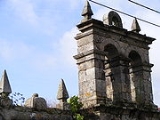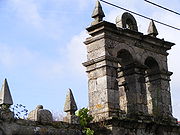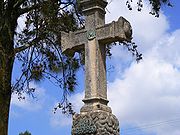
Argoncilhe
Encyclopedia
Argoncilhe is a Portuguese
parish, located in the municipality of Santa Maria da Feira. It has a population of 10,102 inhabitants and a total area of 8.7 km². Its postal code is 4550. Argoncilhe is the parish of the county of Santa Maria da Feira closer to the city of Porto
. It is located in the far north, surrounded by Grijó, Seixezelo
, Olival
and Sandim
, parish of the county of Vila Nova de Gaia
, and Nogueira of Regedoura, Mozelos
, Sanguedo
, Lourosa
and Fiães
. Argoncilhe is a quiet town, with good access (EN1 and A1), which allows its people to come quickly or at the Santa Maria da Feira (10 kilometres), either in Espinho
(8), Gaia
(13) and Porto (15) .
 The origins of Argoncilhe are more remote, apparently, the time pre-Roman
The origins of Argoncilhe are more remote, apparently, the time pre-Roman
, and then the Romans
, to believe in toponymy and the archaeological findings, particularly in Aldriz (place of Castro
), which would be located several "villas"
.
Regarding the origin of the name, is not so unanimous. There are even two versions, pointing to two distinct possibilities etimológicas. According to the first, Argoncilhe comes from "areucillus", in turn diminutive of "areub" (arch), resulting then in Latin, "arcucillus" and finally "arcucillis" and would ultimately "Argoncilhe" (small arch). The second, pointing Argoncilhe genitive as the name "Dragoncellus", having evolved as follows: "Dragunceli" (1086), "Draguncelli" (1091), "Dragoncelli" (1100 and 1102), "Dragonzell" (1114) , "Ecllesian Sancti Martini of Argoncilhi" (1320), "St. Martin of Dragoncilhi" (1337).
 The oldest written document referencing Argoncilhe appears in 1086, proving the donation, for Sancha Bermudez, of several buildings of the villa of Eldriz "(Aldriz) to the Church of St. Martin. A few years later, in 1091, are Ragui Ramirez and Ruderico Gunsalvez to refer to the parish, in a letter of shares established with D. Soeiro Formarigues, for property near the Mount of Pena (Outeiro of Pena), at the villa Dragoncelli. " References follow up over the years, as of 1100, with D. Soeiro Formarigues player again, to acquire the assets of the "villa Dragoncelli of" belonging to Elvira Gouviaz.
The oldest written document referencing Argoncilhe appears in 1086, proving the donation, for Sancha Bermudez, of several buildings of the villa of Eldriz "(Aldriz) to the Church of St. Martin. A few years later, in 1091, are Ragui Ramirez and Ruderico Gunsalvez to refer to the parish, in a letter of shares established with D. Soeiro Formarigues, for property near the Mount of Pena (Outeiro of Pena), at the villa Dragoncelli. " References follow up over the years, as of 1100, with D. Soeiro Formarigues player again, to acquire the assets of the "villa Dragoncelli of" belonging to Elvira Gouviaz.
Feature marked the history of medieval Argoncilhe is its intrinsic link early and the Grijó
. In 1093, was one of seven patroados donated to the monastery of Grijó, along with Perosinho, Serzedo, Grijó, Travanca de Bemposta, S. Miguel de Travaçô and Teirol. A donation made by D. Bernardo, Bishop of Coimbra
, reformed and then in 1137, by Bishop John, churches in the area of Porto
(which has spread in the lands of Fair), or Argoncilhe, Perosinho, Serzedo and Grijó. A situation which remained until 1686, when the parish is independent of the Convent of Crúzios of Grijó, until 1834.
As in most of the national territory, also in Argoncilhe agriculture was the main activity on the threshold of the 20th century. The first industries have arisen in the area of woods and locks, and only as of 1920/1930 reason there is a relative spread of small industrial units.
Since always, agriculture was the main activity of Argoncilhe, but from the 20th century were the first industries in the area of woods and locks. From the 30, appear in many, small industries. At this point, wins the importance of manufacturing employment for cooperage
, responsible for the creation of a large number of jobs as well as the dissemination of the arts to construction. The operation of wolfram
was also a crucial milestone in the history of the town, between 1939 and 1945, responsible for big business, but also by emigration to Venezuela
, Brazil
, France
and Germany
.
The arrival of electricity to the parish (1951) allowed a breakthrough in agricultural and industrial modernization. The April 14, 1985, Argoncilhe gained the status of Vila, a crucial milestone. Since then, it has been shown a significant development.
 The historical and cultural heritage of Argoncilhe is rich enough to deserve special attention from all those interested by the town's past. Based on religious and archaeological monuments, testimonies given the centuries of progress and change over time, Argoncilhe guard inside it many "pearls" that can and should be visited.
The historical and cultural heritage of Argoncilhe is rich enough to deserve special attention from all those interested by the town's past. Based on religious and archaeological monuments, testimonies given the centuries of progress and change over time, Argoncilhe guard inside it many "pearls" that can and should be visited.
Starting with the religious vein, which has always influenced particularly all places and aggregated population, is in the parish many milestones, in addition to the inevitable and prominent Church, and the characteristic heart of the town. The chapels of Sao Domingo, San Pedro de Sao Tome (with its bell tower) of St. Anthony, the "Senhora do Campo" (Lady of the Field), the Church of "Cristo Rei", all these are clear signs of worship place, and turned into a monument to the legacy posterity.
Along with the dominant religion, also mirrors other archaeological lie on Argoncilhe, such as characteristic of Roçadas Roman Bridge or the Cross Millennial. The picturesque water mills, which still can find, give a grace to own Argoncilhe and are an important part of its historical identity.
 The area features a local sporting team known as the Associação Desportiva de Argoncilhe
The area features a local sporting team known as the Associação Desportiva de Argoncilhe
that play in the first division of the Associação de Futebol de Aveiro district league.
Portugal
Portugal , officially the Portuguese Republic is a country situated in southwestern Europe on the Iberian Peninsula. Portugal is the westernmost country of Europe, and is bordered by the Atlantic Ocean to the West and South and by Spain to the North and East. The Atlantic archipelagos of the...
parish, located in the municipality of Santa Maria da Feira. It has a population of 10,102 inhabitants and a total area of 8.7 km². Its postal code is 4550. Argoncilhe is the parish of the county of Santa Maria da Feira closer to the city of Porto
Porto
Porto , also known as Oporto in English, is the second largest city in Portugal and one of the major urban areas in the Iberian Peninsula. Its administrative limits include a population of 237,559 inhabitants distributed within 15 civil parishes...
. It is located in the far north, surrounded by Grijó, Seixezelo
Seixezelo
Seixezelo is a Portuguese parish in the municipality of Vila Nova de Gaia. It has a population of 1,729 and an area of 1.61 km²....
, Olival
Olival
-Portugal:* Olival , a civil parish in the municipality of Ourem* Olival , a civil parish in the municipality of Vila Nova de GaiaOther variants:* Olival Basto , a civil parish in the municipality of Odivelas...
and Sandim
Sandim
Sandim is a Portuguese town and a parish in the municipality of Vila Nova de Gaia. It has a population of 6,326 and an area of 15.97 km²....
, parish of the county of Vila Nova de Gaia
Vila Nova de Gaia
Vila Nova de Gaia, or simply Gaia is a city in Vila Nova de Gaia Municipality, Portugal. It is located in the Porto District, south of the city of Porto on the other side of the Douro River. The city proper has a population of 178,255 and the municipality contains 24 parishes with a total...
, and Nogueira of Regedoura, Mozelos
Mozelos
Mozelos may refer to two parishes in Portugal:*Mozelos, a parish in the municipality of Paredes de Coura*Mozelos, a parish in the municipality of Santa Maria da Feira...
, Sanguedo
Sanguedo
Sanguedo is a Portuguese parish, located in the municipality of Santa Maria da Feira. It has a population of 3,542 inhabitants and a total area of 4.31 km².-Sporting club:*Associação Desportiva e Cultural de Sanguedo- football...
, Lourosa
Lourosa
Lourosa is the name of multiple locations in Portugal:* Lourosa, a parish in the municipality of Oliveira do Hospital.* Lourosa, a parish in the municipality of Santa Maria da Feira....
and Fiães
Fiães
-Parishes:*Fiães, a parish in the municipality of Melgaço*Fiães, a parish in the municipality of Santa Maria da Feira*Fiães, a parish in the municipality of Trancoso*Fiães, a parish in the municipality of Valpaços-Other:...
. Argoncilhe is a quiet town, with good access (EN1 and A1), which allows its people to come quickly or at the Santa Maria da Feira (10 kilometres), either in Espinho
Espinho, Portugal
Espinho is a city in Espinho Municipality in Portugal. It is a reputed beach resort and a zone of legal gambling with a casino - Casino Solverde. Its fair - Feira de Espinho, having been first organised in 1894, is well known in Portugal...
(8), Gaia
Vila Nova de Gaia
Vila Nova de Gaia, or simply Gaia is a city in Vila Nova de Gaia Municipality, Portugal. It is located in the Porto District, south of the city of Porto on the other side of the Douro River. The city proper has a population of 178,255 and the municipality contains 24 parishes with a total...
(13) and Porto (15) .
History

Lusitanians
The Lusitanians were an Indo-European people living in the Western Iberian Peninsula long before it became the Roman province of Lusitania . They spoke the Lusitanian language which might have been Celtic. The modern Portuguese people see the Lusitanians as their ancestors...
, and then the Romans
Lusitania
Lusitania or Hispania Lusitania was an ancient Roman province including approximately all of modern Portugal south of the Douro river and part of modern Spain . It was named after the Lusitani or Lusitanian people...
, to believe in toponymy and the archaeological findings, particularly in Aldriz (place of Castro
Castro culture
Castro culture is the archaeological term for naming the Celtic archaeological culture of the northwestern regions of the Iberian Peninsula from the end of the Bronze Age until it was subsumed in local Roman culture...
), which would be located several "villas"
Villa
A villa was originally an ancient Roman upper-class country house. Since its origins in the Roman villa, the idea and function of a villa have evolved considerably. After the fall of the Roman Republic, villas became small farming compounds, which were increasingly fortified in Late Antiquity,...
.
Regarding the origin of the name, is not so unanimous. There are even two versions, pointing to two distinct possibilities etimológicas. According to the first, Argoncilhe comes from "areucillus", in turn diminutive of "areub" (arch), resulting then in Latin, "arcucillus" and finally "arcucillis" and would ultimately "Argoncilhe" (small arch). The second, pointing Argoncilhe genitive as the name "Dragoncellus", having evolved as follows: "Dragunceli" (1086), "Draguncelli" (1091), "Dragoncelli" (1100 and 1102), "Dragonzell" (1114) , "Ecllesian Sancti Martini of Argoncilhi" (1320), "St. Martin of Dragoncilhi" (1337).

Feature marked the history of medieval Argoncilhe is its intrinsic link early and the Grijó
Grijó
-In Portugal:*Grijó, a parish in Macedo de Cavaleiros*Grijó, a parish in Vila Nova de GaiaIt is part of a name of a parish:*Grijó de Parada, a parish in Bragança...
. In 1093, was one of seven patroados donated to the monastery of Grijó, along with Perosinho, Serzedo, Grijó, Travanca de Bemposta, S. Miguel de Travaçô and Teirol. A donation made by D. Bernardo, Bishop of Coimbra
Coimbra
Coimbra is a city in the municipality of Coimbra in Portugal. Although it served as the nation's capital during the High Middle Ages, it is better-known for its university, the University of Coimbra, which is one of the oldest in Europe and the oldest academic institution in the...
, reformed and then in 1137, by Bishop John, churches in the area of Porto
Porto
Porto , also known as Oporto in English, is the second largest city in Portugal and one of the major urban areas in the Iberian Peninsula. Its administrative limits include a population of 237,559 inhabitants distributed within 15 civil parishes...
(which has spread in the lands of Fair), or Argoncilhe, Perosinho, Serzedo and Grijó. A situation which remained until 1686, when the parish is independent of the Convent of Crúzios of Grijó, until 1834.
As in most of the national territory, also in Argoncilhe agriculture was the main activity on the threshold of the 20th century. The first industries have arisen in the area of woods and locks, and only as of 1920/1930 reason there is a relative spread of small industrial units.
Since always, agriculture was the main activity of Argoncilhe, but from the 20th century were the first industries in the area of woods and locks. From the 30, appear in many, small industries. At this point, wins the importance of manufacturing employment for cooperage
Cooper (profession)
Traditionally, a cooper is someone who makes wooden staved vessels of a conical form, of greater length than breadth, bound together with hoops and possessing flat ends or heads...
, responsible for the creation of a large number of jobs as well as the dissemination of the arts to construction. The operation of wolfram
Wolfram
Wolfram may refer to:* Wolfram, the chemical element tungsten* Wolfram syndrome, genetic condition* Wolfram Research, software company* Wolfram Alpha, interactive Web site...
was also a crucial milestone in the history of the town, between 1939 and 1945, responsible for big business, but also by emigration to Venezuela
Venezuela
Venezuela , officially called the Bolivarian Republic of Venezuela , is a tropical country on the northern coast of South America. It borders Colombia to the west, Guyana to the east, and Brazil to the south...
, Brazil
Brazil
Brazil , officially the Federative Republic of Brazil , is the largest country in South America. It is the world's fifth largest country, both by geographical area and by population with over 192 million people...
, France
France
The French Republic , The French Republic , The French Republic , (commonly known as France , is a unitary semi-presidential republic in Western Europe with several overseas territories and islands located on other continents and in the Indian, Pacific, and Atlantic oceans. Metropolitan France...
and Germany
Germany
Germany , officially the Federal Republic of Germany , is a federal parliamentary republic in Europe. The country consists of 16 states while the capital and largest city is Berlin. Germany covers an area of 357,021 km2 and has a largely temperate seasonal climate...
.
The arrival of electricity to the parish (1951) allowed a breakthrough in agricultural and industrial modernization. The April 14, 1985, Argoncilhe gained the status of Vila, a crucial milestone. Since then, it has been shown a significant development.
More Symbolic Places

Starting with the religious vein, which has always influenced particularly all places and aggregated population, is in the parish many milestones, in addition to the inevitable and prominent Church, and the characteristic heart of the town. The chapels of Sao Domingo, San Pedro de Sao Tome (with its bell tower) of St. Anthony, the "Senhora do Campo" (Lady of the Field), the Church of "Cristo Rei", all these are clear signs of worship place, and turned into a monument to the legacy posterity.
Along with the dominant religion, also mirrors other archaeological lie on Argoncilhe, such as characteristic of Roçadas Roman Bridge or the Cross Millennial. The picturesque water mills, which still can find, give a grace to own Argoncilhe and are an important part of its historical identity.
Sporting

Associação Desportiva de Argoncilhe
The Associação Desportiva de Argoncilhe is a local football club located in the parish of Argoncilhe in the municipality of Santa Maria da Feira, district of Aveiro in Portugal.-League:...
that play in the first division of the Associação de Futebol de Aveiro district league.

